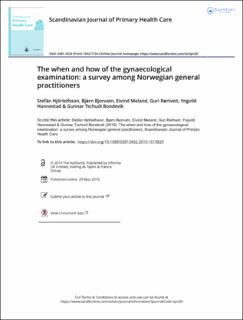| dc.contributor.author | Hjørleifsson, Stefan | |
| dc.contributor.author | Bjorvatn, Bjørn | |
| dc.contributor.author | Meland, Eivind | |
| dc.contributor.author | Rørtveit, Guri | |
| dc.contributor.author | Hannestad, Yngvild Skåtun | |
| dc.contributor.author | Bondevik, Gunnar Tschudi | |
| dc.date.accessioned | 2020-03-26T14:21:27Z | |
| dc.date.available | 2020-03-26T14:21:27Z | |
| dc.date.created | 2019-07-30T12:29:55Z | |
| dc.date.issued | 2019 | |
| dc.identifier.citation | Scandinavian Journal of Primary Health Care. 2019, 37 (2), 264-270. | |
| dc.identifier.issn | 0281-3432 | |
| dc.identifier.uri | https://hdl.handle.net/11250/2648930 | |
| dc.description.abstract | Introduction: Little is known about the indications general practitioners (GPs) perceive as relevant for performing gynaecological examinations (GEs), how GPs master the GE and associated procedures, and how they handle the sensitive nature of GEs.
Methods: In 2015, 70 medical students at the University of Bergen distributed a questionnaire to all 175 GPs in the practices they visited. The questions covered practical routines related to GEs, insertion of intrauterine device, frequency of GEs in different clinical settings and use of assisting personnel. Statistical analyses included chi-square tests and multiple logistic regressions adjusting for age, gender, specialization and localization.
Results: Ninety male and 61 female GPs (87% of invited GPs) responded to the questionnaire. A minority (8%) usually had other staff present during GEs. Compared with female colleagues, male GPs performed bimanual palpation significantly less often in connection with routine Pap smear (AOR 0.3 (95% CI 0.1-0.6)). Twenty-eight percent of the GPs stated that they often/always omitted the GE if the patient was anxious about GE and 35% when the patient asked for referral to a gynaecologist. Omission was more frequent among male GPs. When the GP decided to refer to a gynaecologist based on the patient’s symptoms, more male than female GPs omitted GE (AOR 2.5 (95% CI 1.1-5.4)).
Conclusion: Male gender of the GP may be associated with barriers to medical evaluation of pelvic symptoms in women, potentially leading to substandard care. Possibly, however, male GPs’ reluctance to perform the GE may also limit unnecessary bimanual palpation in asymptomatic women. | |
| dc.language.iso | eng | |
| dc.rights | CC BY 4.0 | |
| dc.rights.uri | https://creativecommons.org/licenses/by/4.0/ | |
| dc.title | The when and how of the gynaecological examination: a survey among Norwegian general practitioners | |
| dc.type | Peer reviewed | |
| dc.type | Journal article | |
| cristin.ispublished | true | |
| cristin.qualitycode | 1 | |
| dc.identifier.doi | 10.1080/02813432.2019.1619829 | |
| dc.identifier.cristin | 1713191 | |
| dc.source.journal | Scandinavian Journal of Primary Health Care | |
| dc.source.volume | 37 | |
| dc.source.issue | 2 | |
| dc.source.pagenumber | 264-270 | |

